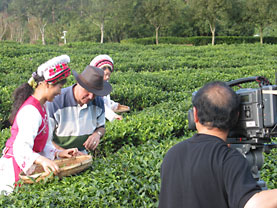
After days of glorious sun in Yunnan it is raining as we leave Lijiang and fly the short hop to Kunming, Yunnan's capital. Just a few months earlier Beckham fever had gripped the city when the England captain and former Manchester United hero arrived with his new Real Madrid team-mates for pre-season training in Kunming which kicked off the teamís two-week Asia roadshow. Hundreds of fans had crammed into the airport and lined the streets to welcome David and his fellow football goliaths. Our arrival goes unnoticed.
Situated on Yunnanís central plain, nearly 1,900 metres above sea level, Kunming is sheltered from cold northerly winds by mountains and bathed in warm air currents from the Indian subcontinent. Dianchi Lake to the south also acts like a giant air conditioner. As a result, Kunming has mild winters and summers. It is the city of eternal spring and flowers bloom all year round. Yunnan is known as the Kingdom of Plants. Its temperate climate, abundant rain and sunshine and fertile soil makes it Chinaís flora treasure house, its 18,000-plus plant species representing over 60 per cent of all those in China. It is also one of the world's foremost plant nurseries. Botanists and plant collectors have been bringing back samples of its horticultural riches to the West for more than 100 years, and numerous varieties now common in gardens throughout the world are descended from wild flowers discovered in Yunnan.
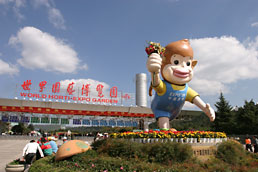

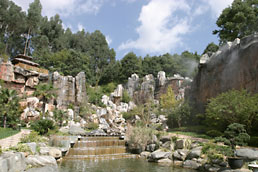
We are in Kunming to film at the World Horti-Expo Garden, site of the 1999 World Horticultural Expo. The floral version of the World Expo events, this was the biggest exposition ever staged in China and attracted some nine million visitors from all over the world. It was originally due to have been staged in Beijing but was switched to Yunnan because of its more equitable climate. Hosting the event was not only prestigious for Kunming, it also proved a tremendous financial boost as well and spurred an unprecedented building boom. New projects included the expansion of its airport to handle 10 million passengers a year, new hotels and a major road-building programme. As we drive from the airport I am happy to see some vestiges of its past, in the form of horse-drawn charabancs laden with passengers sheltering from the rain which share the roads with the ever increasing number of new cars.
Just before we reach our hotel, which adjoins the Expo complex, I noticed a large B&Q store. I had seen other large Western stores and many fast-food restaurants in China, evidence of its increasing globalisation. But a do-it-yourself superstore? Somehow I just canít bring to mind the image of Chinese people spending their weekends doing DIY projects in the home or garden as we do back in the UK. Especially as most live in apartments with no gardens or space to expand. How long will it be before Chinese television is full of programmes like Ground Force or Changing Rooms?
We are taken on a quick orientation tour of the Expo site by the general manager of its parent group and some colleagues. It is vast. Once a stone quarry it encompasses five exhibition halls, outdoor exhibition areas, seven special gardens, 32 international exhibition gardens and 34 domestic exhibition gardens. A tourist trail winds 10km throughout the garden park, a cable car runs over wooded hills to the neighbouring Palace Park, and a futuristic observation tower stands sentry above it all Ė ostensibly an open lotus flower but looking more like a satellite dish or a giant raygun from an episode of Dr Who or a James Bond film with its dish pointing to the heavens. We stop at a vantage point over the lower part of the garden after a heavy shower. A rainbow rises from a hillside beyond a cliff etched with the Expo 99 logo and a full size Dutch windmill, arcing over the gardens and exhibition halls. The observation tower is on the opposite hill, and I half expect it to respond with a bolt of electricity up into the slate grey clouds.
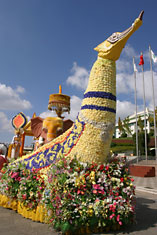
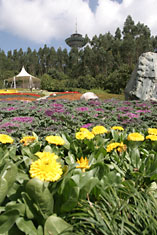
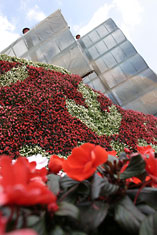
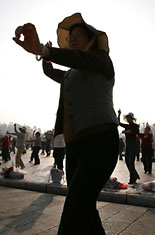
As we head back to the hotel I wonder how I will manage to make it through the next few days. Gardens and me donít get along. I love the beauty of plants and flowers. I even watch the occasional gardening programme on TV. I have been known to venture out into our back garden on the occasional hot day, and enjoy rustling up barbecues on summer evenings. But I leave the gardening to my wife because I suffer terribly from hay fever when plants start to blossom or anyone in the vicinity mows the grass. For the same reason I canít stand flowers in the house, unless theyíre artificial. So why am I spending four days in a giant garden full of more than 2,500 species of plants, some of which I am highly allergic to? Good job I have my hay fever medication with me. A mask and noseclip wouldnít go amiss either.
On the first evening we are taken to a dinner show at the nearby Jixin Banquet Restaurant. It features a Yunnan feast and a musical spectacular based on the province's many ethnic minority groups. The place is packed but rather than the traditional tribal dances I expect this show owes more to the glitz of a Las Vegas themed hotel. The owner tells me on camera his vision was to create an experience combining the Moulin Rouge with exotic Thai dance shows. I ask whether it appeals to Westerners who might want a more authentic experience, and he assures me it is popular. Even the Queen apparently enjoyed it when she attended a show during the opening of Expo.
Our first real foray into the garden is to visit the China exhibition hall, which depicts some of China's rich history including the voyages of discovery by maritime explorer Zheng He more than 70 years before Columbus crossed the Atlantic. We move on to the main outdoor exhibition area near the entrance. The focal point is a massive three-masted Chinese junk, sailing on a sea of red and yellow flowers. The peace is broken by four floats which cruise past blaring out loud pop music. One has an oversized monkey wearing blue-bibbed shorts as its centrepiece - the park's mascot, Lingling, representing Yunnan's rare golden monkey. Later we go to the front entrance to meet the park's retired chief horticultural engineer, Mr Yen, who will guide me around its various gardens. The car park is full of wedding parties who have come to be photographed by a huge big pink-lipped statue of Lingling. I can only think he is regarded as some sort of good luck or fertility symbol. A sign above the entrance gate bears the curious English translation: ďWeLcome to the World Horti-Expo Garden Ė the State Demonstrate Spot of Courteous and Honest Scenic Area.Ē It is a classic example of the wonderful Chinglish (Chinese English) signs you see everywhere in China.
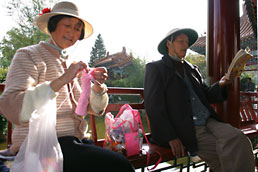
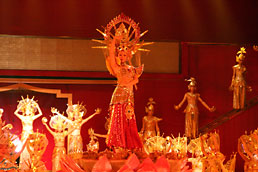
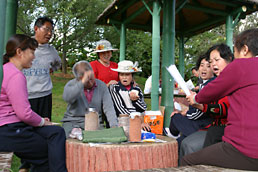
One stop we make is at the British garden. It is supposed to be a castle, inside which is a traditional Scottish cottage. During Expo the cottage was manned by a Scotsman who, according to Yunnan Tourismís website, would call visitors a ďblokeĒ for only two yuan. He isnít there to greet me, thankfully.
We move on to the herb garden to film. The Chinese have long known the medicinal properties of herbs. Mr Yen explains that there are 500 species of herb in the garden, many of them used to cure ailments and diseases. Among them is the du zhong or eucommia tree, a temperate rubber tree whose bark has curative effects as well as having longevity benefits similar to ginseng. Identifying the correct plant is crucial in herbal medicine, and Mr Yen shows me how to make sure the tree in question is the right one by carefully tearing a leaf and pulling it apart to reveal its sinewy veins. I manage it after three attempts, but would not risk my life by trying it for real in the wild.
We pass groups of locals enjoying the weekend in the gardens, some playing mah-jong in the shade of a tree and others singing enthusiastically from songsheets. Another stop is in a garden of wonderfully-sculpted miniature potted trees. I call them bonsai trees but am swiftly corrected. They are penjing, developed by Chinese over 1,000 years ago and subsequently copied by the Japanese as bonsai. Some of the trees here are more than 200 years old and they are displayed in a serene setting around a reflecting pool edged with pavilions. A couple of days later we film in another reflecting pool, this time in the Shandong provincial garden. It is more like a classical Chinese garden and an elderly couple I come across there are enjoying the surroundings and oblivious to everything else, the woman knitting something pink and her husband singing traditional songs from a book.
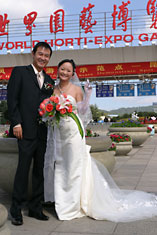
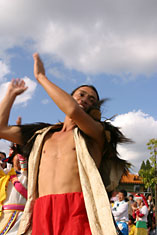
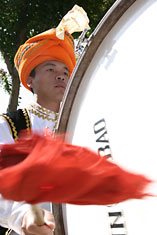
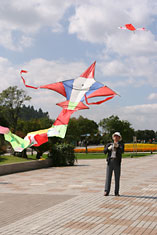
Next stop is the tea garden, the avenues of tea trees reminiscent of scenes throughout the country. China is synonymous with tea and human cultivation of tea plants dates back 2,000 years. Most of the garden's trees are about 45 years old, but apparently they can grow to as old as 800 and I am shown one 400 years old. It was one of four ancient tea trees transplanted from other locations, a different method used for each one. Sadly it was the only survivor. I ask Mr Yen if it would not be more meaningful to leave ancient specimens in their natural environment rather than move them to the Expo garden. He admits leaving them in the wild is better, but says moving them allows more people to see them and research to be undertaken. It is not a particularly convincing argument to me. Uprooting the venerable trees to put on public display resulted in the world losing some of its oldest living things. Whereas had they been left in their mountain habitats they would almost certainly still be alive now and possibly for future generations. I help some girls in ethnic costume in the laborious task of picking tea leaves and we go to the tea house for the next process. A large electric cauldron is switched on and the basket of leaves is tipped in. It must be hot as the leaves begin sizzling. They need to be parched, a process which brings out the flavour of the tea. One of the girls expertly sifts and turns the leaves with her bare hands without touching the scalding iron sides. I am then invited to try myself, and gingerly put my hands in. My confident grows and after a while I am scooping the leaves properly. I quit while Iím ahead and before I get scalded, and we have a cup of tea made from the leaves we had picked and charred. You can't get fresher than that.
That night's entertainment in the hotel is karaoke, very popular in China. The Chinese pop songs are interspersed with English-language ones including the ubiquitous Unchained Melody, which I decline the offer to sing. Some are more like recruitment videos for the People's Liberation Army, with patriotic music accompanied by shots of China's finest going through their paces with drill routines and slow-motion unarmed combat sequences. Top of the Pops was never like this.
Next day we visit the bamboo garden. It is raining once more and a two-storey exhibition house makes a welcome escape from it for filming. The house and everything in it are made from bamboo. I had no idea it was so versatile or that there were so many different varieties. Yunnan contains 70 per cent of China's bamboo species and 40 per cent of the world's, and the garden contains more than 250 kinds. Bamboo is central to Chinese culture. They began writing on bamboo strips more than 2,500 years ago before it was superseded by another Chinese invention, paper. We also film in the Grand Greenhouse, which is divided into three zones to house tropical, temperate and mountain plants, many of them unique to Yunnan. And we go to the tree garden, where the highlight of the 300-plus varieties of magnolia tree is one so rare only seven examples exist in the wild. Presumably there used to be eight.
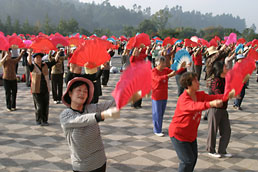
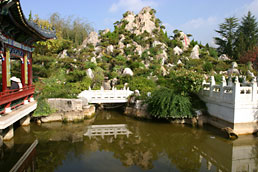
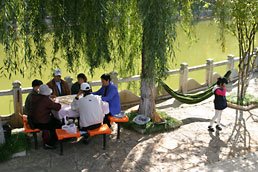
On our final day we come across a mass of people, mainly ladies, doing early morning keep fit exercises to music in front of a large stage. They stretch right across the entrance avenues in 15 or so brightly-coloured rows, many of them wearing fetching hats which could double as lampshades. They use vivid pink and red fans or batons for some of the dances, and they are so well choreographed it reminds me of the flashes of colour you get when shoals of tropical reef fish or flocks of birds make sudden turn in unison. Some have their belongings on the ground in front of them as they dance. Itís a bit like the Chinese equivalent of Essex girls dancing round their handbags, but on a scale you would never see in a Southend disco. As the ladies of the lampshades disperse I talk to the dance maestro, the Expo park's art director who looks more like a martial arts film star. He tells me there are about 4,000 participants today. He sometimes gets 10,000 and once had 30,000. The dances were all devised by him and are based on elements from the cultures of Yunnan's 26 ethnic minorities.
After some of the foods I have eaten in other parts of China, the offerings in Kunming have been strangely normal. Until I am served rose petals fried in batter. I suppose it had to happen with all this floral abundance around. They taste delicate and slightly sweet, but I can't imagine them catching on in my local chippie back home.
The final afternoon in the Expo garden kicks off with a traditional Chinese wedding Ė mine! We stop by a couple of ornate red sedans complete with yellow-suited bearers. Before I know it I have been stitched up and kitted out in a dazzling red gown with a dragon motif on the chest and ridiculously long red and white sleeves that would outdo interior designer Laurence Llewellyn-Bowen any day. I also have to wear a strange and ill-fitting hat with paddles sticking out of the sides. My bride turns out to be the assistant from the morningís mass fitness dance. She is dressed in a matching outfit with a spiky silver and blue hat which is covered with a silk cloth. I lead her to her sedan with some more silk before I can clamber into mine. Just like in the West, it is considered bad luck for the groom to see his bride before the wedding. The sedans are then lifted on long bamboo poles by the sedan bearers who donít so much walk as run, urged on by the shrill wailing of traditional reed instruments. I start to feel butterflies in my stomach, but it isnít from nerves. The bouncing motion of the bamboo poles is making me feel sedansick. Back on terra firma I go over to fetch my bride from her sedan. I kiss her hand and give her a quick peck on the cheek, but when I take off my gown and hat she has disappeared. Iíve got married and divorced all in the space of 10 minutes. And I didnít even find out her name. Maybe someone told her I already had a wife and three children back home in England.
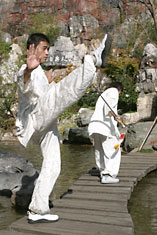
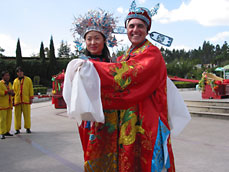
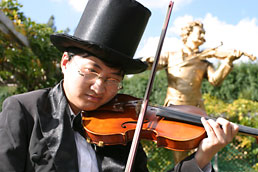
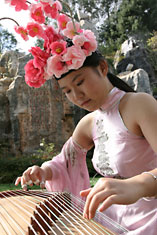
Music is the theme for our last film sequences. We go to a garden area with a waterfall and high cliffs, where a girl in a pretty long silk dress and a hat topped with flowers on wire stems is playing a guzheng, a traditional string instrument like a zither. Two men are doing tai chi on a bridge in the background, one of them with a sword. We film another girl playing a guzheng in a pavilion in the Hubei provincial garden, while a group of dancers in ethnic costume are performing to the beat of drums in another garden nearby. But my favourite stop is at the Austria garden where a string quartet is setting up in front of a golden statue of Johann Strauss. The three violinists and cellist are improbably dressed in home-made top hats and crumpled evening suits complete with tails. They are obviously meant to lend an air of culture and sophistication to the garden. But their dress sense is more Charlie Chaplin than Albert Hall and at times they are painfully out of tune. We are deep in south-west China, though, so I canít expect Savile Row tailoring or the Vienna Conservatory. The audience applauds warmly when they finish and I join in, but not too enthusiastically Ė just in case they are encouraged to play an encore. Would they follow their Strauss serenades in this garden by playing Bach to the fuchsias in the German garden? I never did find out.
We leave the garden and head to a rural village, where we fish for our supper at a small building with its own fish ponds. It gives me time to reflect on the Expo park and conversations I had with the managers. The garden complex is a great showcase for the botanic riches of Yunnan and China. Its theme is Man and Nature in Harmony. Given how mankind's greed or thoughtlessness has had and continues to have such a devastating impact on so much of nature's flora and fauna, I find it a noble sentiment yet one sadly at odds with reality in many areas of the world. I am also left questioning whether their desire to exhibit rare floral treasures is always in the interests of the plants. Another dilemma facing them is where they go from here. More than four years after the razzmatazz of Expo is it time, perhaps, to look more to the future and find a new theme or identity? Should they add more theme park elements, or will that only serve to deter those visitors with a true interest in seeing some of the world's rarest plants? I don't envy them the task and I wish them luck. I would also thoroughly recommend anyone visiting Kunming to spend time to viewing the garden's wonderful displays, even hay fever sufferers.
Next stop: Jiangsu.